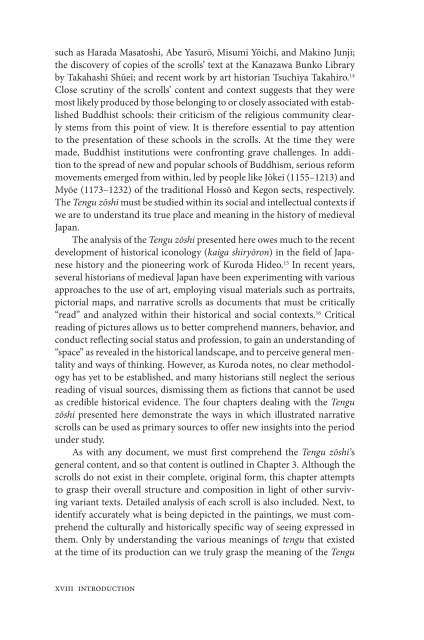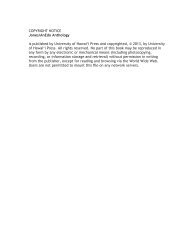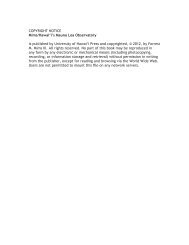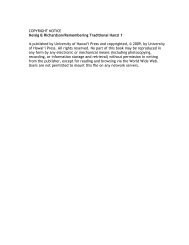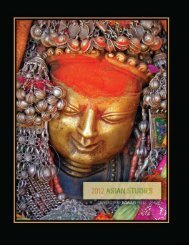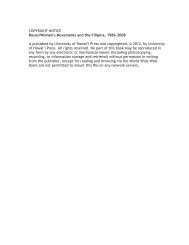COPYRIGHT NOTICE Wakabayashi/The Seven Tengu Scrolls is ...
COPYRIGHT NOTICE Wakabayashi/The Seven Tengu Scrolls is ...
COPYRIGHT NOTICE Wakabayashi/The Seven Tengu Scrolls is ...
Create successful ePaper yourself
Turn your PDF publications into a flip-book with our unique Google optimized e-Paper software.
such as Harada Masatoshi, Abe Yasurō, M<strong>is</strong>umi Yōichi, and Makino Junji;<br />
the d<strong>is</strong>covery of copies of the scrolls’ text at the Kanazawa Bunko Library<br />
by Takahashi Shūei; and recent work by art h<strong>is</strong>torian Tsuchiya Takahiro. 14<br />
Close scrutiny of the scrolls’ content and context suggests that they were<br />
most likely produced by those belonging to or closely associated with establ<strong>is</strong>hed<br />
Buddh<strong>is</strong>t schools: their critic<strong>is</strong>m of the religious community clearly<br />
stems from th<strong>is</strong> point of view. It <strong>is</strong> therefore essential to pay attention<br />
to the presentation of these schools in the scrolls. At the time they were<br />
made, Buddh<strong>is</strong>t institutions were confronting grave challenges. In addition<br />
to the spread of new and popular schools of Buddh<strong>is</strong>m, serious reform<br />
movements emerged from within, led by people like Jōkei (1155–1213) and<br />
Myōe (1173–1232) of the traditional Hossō and Kegon sects, respectively.<br />
<strong>The</strong> <strong>Tengu</strong> zōshi must be studied within its social and intellectual contexts if<br />
we are to understand its true place and meaning in the h<strong>is</strong>tory of medieval<br />
Japan.<br />
<strong>The</strong> analys<strong>is</strong> of the <strong>Tengu</strong> zōshi presented here owes much to the recent<br />
development of h<strong>is</strong>torical iconology (kaiga shiryōron) in the field of Japanese<br />
h<strong>is</strong>tory and the pioneering work of Kuroda Hideo. 15 In recent years,<br />
several h<strong>is</strong>torians of medieval Japan have been experimenting with various<br />
approaches to the use of art, employing v<strong>is</strong>ual materials such as portraits,<br />
pictorial maps, and narrative scrolls as documents that must be critically<br />
“read” and analyzed within their h<strong>is</strong>torical and social contexts. 16 Critical<br />
reading of pictures allows us to better comprehend manners, behavior, and<br />
conduct reflecting social status and profession, to gain an understanding of<br />
“space” as revealed in the h<strong>is</strong>torical landscape, and to perceive general mentality<br />
and ways of thinking. However, as Kuroda notes, no clear methodology<br />
has yet to be establ<strong>is</strong>hed, and many h<strong>is</strong>torians still neglect the serious<br />
reading of v<strong>is</strong>ual sources, d<strong>is</strong>m<strong>is</strong>sing them as fictions that cannot be used<br />
as credible h<strong>is</strong>torical evidence. <strong>The</strong> four chapters dealing with the <strong>Tengu</strong><br />
zōshi presented here demonstrate the ways in which illustrated narrative<br />
scrolls can be used as primary sources to offer new insights into the period<br />
under study.<br />
As with any document, we must first comprehend the <strong>Tengu</strong> zōshi’s<br />
general content, and so that content <strong>is</strong> outlined in Chapter 3. Although the<br />
scrolls do not ex<strong>is</strong>t in their complete, original form, th<strong>is</strong> chapter attempts<br />
to grasp their overall structure and composition in light of other surviving<br />
variant texts. Detailed analys<strong>is</strong> of each scroll <strong>is</strong> also included. Next, to<br />
identify accurately what <strong>is</strong> being depicted in the paintings, we must comprehend<br />
the culturally and h<strong>is</strong>torically specific way of seeing expressed in<br />
them. Only by understanding the various meanings of tengu that ex<strong>is</strong>ted<br />
at the time of its production can we truly grasp the meaning of the <strong>Tengu</strong><br />
xviii introduction


